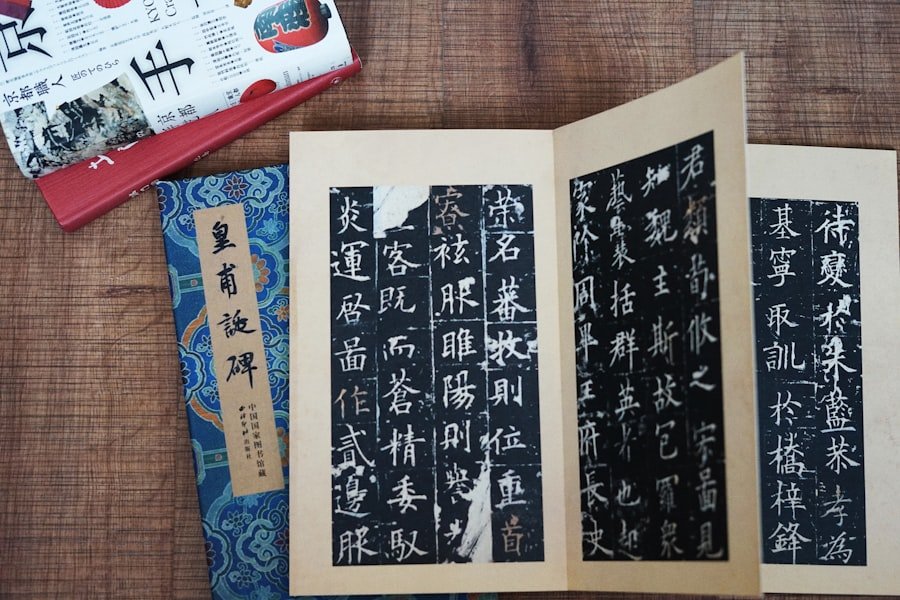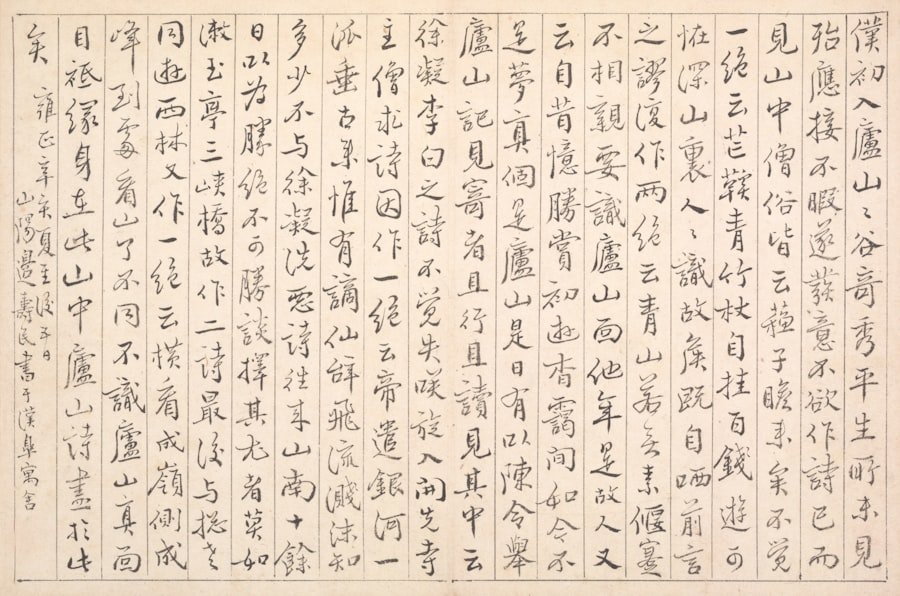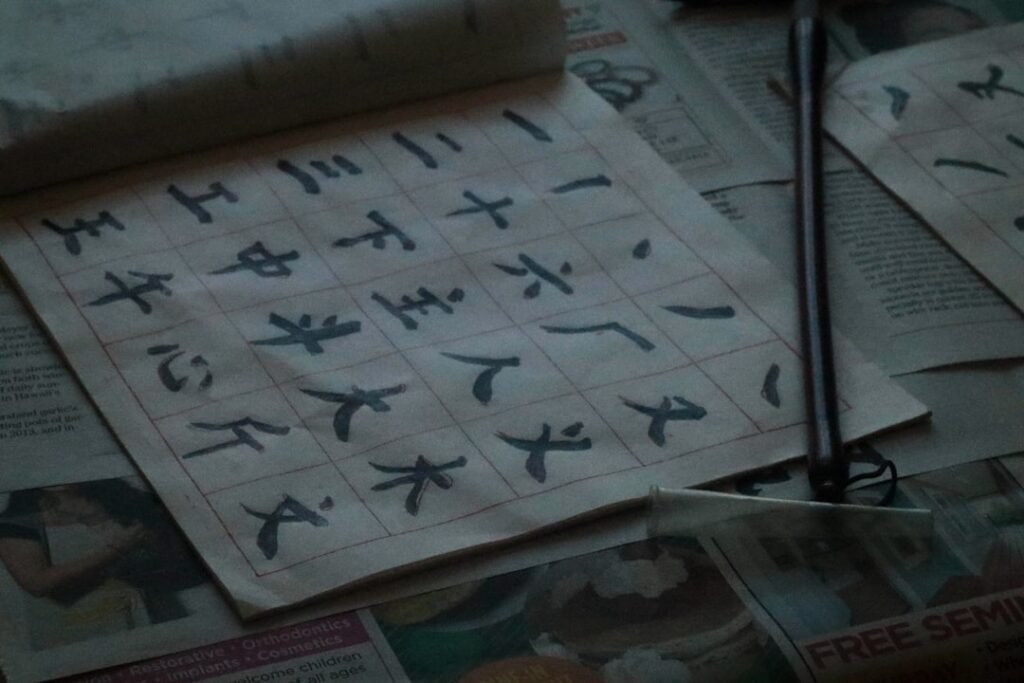Chinese calligraphy is an ancient art form that transcends mere writing; it embodies a philosophy, a way of life, and a deep cultural heritage. At the heart of this practice lies the calligraphy brush, an instrument that is not only functional but also symbolic. The brush serves as an extension of the artist’s hand, allowing for the expression of emotions and thoughts through fluid strokes and intricate designs.
The quality and condition of the brush can significantly influence the outcome of a piece, making it essential for practitioners to understand its importance. The craftsmanship of Chinese calligraphy brushes is remarkable, with each brush made from a variety of materials such as animal hair, bamboo, and sometimes even synthetic fibres. The type of hair used can affect the brush’s flexibility, absorbency, and overall performance.
For instance, goat hair brushes are known for their softness and ability to hold ink well, while wolf hair brushes offer a firmer touch for more precise strokes. Understanding these nuances not only enhances the calligrapher’s skill but also fosters a deeper appreciation for the art form itself. Therefore, maintaining the brushes in optimal condition is crucial for anyone serious about their calligraphy practice. Master the art of Chinese calligraphy. Enroll now at the LC Chinese School in Oslo.
Table of Contents
ToggleSummary
- Chinese calligraphy brushes are important tools for traditional Chinese art and culture, and proper care is essential for their longevity and performance.
- Choose soft and gentle cleaning tools and materials to avoid damaging the delicate bristles of your Chinese calligraphy brushes.
- Follow a step-by-step guide to cleaning your Chinese calligraphy brushes, including using a mild soap and lukewarm water to remove ink and residue.
- Properly dry and store your brushes to prevent damage and maintain their shape and performance over time.
- Prevent damage to your brushes by avoiding exposure to extreme temperatures, excessive moisture, and direct sunlight, and by handling them with care during use and cleaning.
Choosing the Right Cleaning Tools and Materials
To ensure that your Chinese calligraphy brushes remain in excellent condition, it is vital to select appropriate cleaning tools and materials. The cleaning process should be gentle yet effective, as harsh chemicals or abrasive materials can damage the delicate bristles. A soft sponge or cloth is ideal for cleaning, as it can remove ink residue without causing harm.
Additionally, using lukewarm water is recommended, as it helps dissolve the ink without compromising the integrity of the brush. When it comes to cleaning solutions, it is best to opt for mild soaps or specially formulated brush cleaners that are designed for use with calligraphy brushes. These products are gentle on the bristles while effectively breaking down ink and other residues.
Avoid using harsh detergents or solvents, as they can strip the natural oils from the hair and lead to premature wear. By carefully selecting your cleaning tools and materials, you can ensure that your brushes remain functional and beautiful for years to come.
Step-by-Step Guide to Cleaning Your Chinese Calligraphy Brushes

Cleaning your Chinese calligraphy brushes may seem daunting at first, but with a systematic approach, it can be a straightforward process. Begin by rinsing the brush under lukewarm water to remove any excess ink. It is essential to hold the brush with the bristles facing downwards to prevent water from seeping into the ferrule—the metal part that holds the bristles—where it can cause damage over time.
Gently squeeze the bristles to expel any remaining ink without pulling or tugging at them. Next, apply a small amount of your chosen cleaning solution to the bristles. Using your fingers or a soft sponge, work the cleaner into the bristles in a circular motion.
This technique helps to lift any stubborn ink particles while ensuring that you do not damage the delicate hairs. Rinse thoroughly under lukewarm water until all traces of soap are gone, and repeat this process if necessary. Once clean, gently reshape the brush head with your fingers to restore its original form before proceeding to dry and store it properly.
Drying and Storing Your Brushes Properly
After cleaning your brushes, proper drying and storage are crucial to maintaining their longevity. Avoid using heat sources such as hairdryers or radiators, as excessive heat can warp or damage the bristles. Instead, lay the brushes flat on a clean towel or hang them upside down in a well-ventilated area.
This method allows any remaining moisture to escape without compromising the shape of the brush. When it comes to storage, consider using a protective case or brush holder that keeps the bristles safe from dust and potential damage. Storing brushes upright in a container can lead to bending or fraying of the bristles over time; therefore, it is advisable to keep them in a position that maintains their shape.
By taking these precautions during drying and storage, you can significantly extend the life of your calligraphy brushes.
Preventing Damage to Your Brushes
Preventing damage to your Chinese calligraphy brushes requires mindfulness during both use and maintenance. One common mistake is applying excessive pressure while writing, which can lead to bent or broken bristles. Practising control and finesse in your strokes will not only improve your calligraphy skills but also protect your brushes from unnecessary wear.
Additionally, be cautious about how you handle your brushes during cleaning. Avoid pulling on the bristles or using abrasive materials that could cause fraying or breakage. It is also wise to keep your brushes away from direct sunlight or extreme temperatures, as these conditions can degrade the materials over time.
By being proactive in your approach to care and handling, you can prevent damage and ensure that your brushes remain in prime condition.
Regular Maintenance and Care Tips

Regular maintenance is key to keeping your Chinese calligraphy brushes in optimal condition. After each use, it is advisable to rinse them immediately to prevent ink from drying on the bristles. This simple step can save you considerable effort during cleaning sessions and prolongs the life of your brushes significantly.
In addition to routine cleaning, consider giving your brushes a more thorough maintenance session every few months. This could involve using a specialised brush conditioner that nourishes the bristles and helps maintain their flexibility and shape. Such products are designed to penetrate deep into the hairs, restoring their natural oils and ensuring they perform at their best.
By incorporating these regular maintenance practices into your routine, you will find that your brushes remain effective tools for your artistic expression.
Removing Stubborn Stains and Residue
Despite diligent cleaning efforts, stubborn stains and residue may occasionally cling to your Chinese calligraphy brushes. In such cases, it is essential to approach removal with care to avoid damaging the bristles. One effective method is to soak the brush in a mixture of lukewarm water and mild soap for several minutes.
This soaking process allows the ink particles to loosen before you attempt further cleaning. If stains persist after soaking, consider using a soft toothbrush or similar tool to gently scrub the bristles while rinsing under running water. This technique can help dislodge any remaining residue without causing harm to the delicate hairs.
Always remember to rinse thoroughly after any scrubbing to ensure no soap remains in the bristles, as this could lead to build-up over time.
Keeping Your Brushes in Good Condition for Longevity
To ensure that your Chinese calligraphy brushes remain in good condition for years to come, it is essential to adopt a holistic approach to care. This includes not only regular cleaning but also being mindful of how you use them during practice sessions. Avoiding excessive pressure and maintaining a light touch will help preserve the integrity of the bristles.
Furthermore, consider rotating between multiple brushes if you frequently engage in calligraphy practice. This rotation allows each brush time to rest between uses, reducing wear and tear on any single brush. By implementing these strategies into your routine, you will find that your brushes not only last longer but also perform better over time.
The Role of Brush Cleaners and Conditioners
Brush cleaners and conditioners play an integral role in maintaining Chinese calligraphy brushes’ performance and longevity. These specialised products are formulated to gently cleanse while nourishing the bristles, ensuring they remain flexible and responsive during use. Regular application of a quality conditioner can help restore lost oils and prevent brittleness that often comes with age or frequent use.
When selecting a brush cleaner or conditioner, look for products specifically designed for calligraphy tools rather than general-purpose cleaners. These specialised formulations are tailored to address the unique needs of brush materials and will provide optimal results without risking damage. Incorporating these products into your maintenance routine will enhance your overall experience with calligraphy.
Common Mistakes to Avoid When Cleaning Your Brushes
While cleaning Chinese calligraphy brushes may seem straightforward, several common mistakes can lead to damage or reduced performance over time. One prevalent error is neglecting to rinse thoroughly after cleaning; leftover soap can cause build-up that affects both performance and longevity. Always ensure that all cleaning agents are completely washed away before drying.
Another mistake is using hot water during cleaning; hot water can warp or damage delicate bristles made from natural hair. Stick with lukewarm water for all cleaning processes to maintain optimal conditions for your brushes. By being aware of these common pitfalls and taking steps to avoid them, you can ensure that your brushes remain in excellent condition.
Seeking Professional Help for Restoration and Repair
Despite our best efforts at maintenance, there may come a time when professional help is needed for restoration or repair of Chinese calligraphy brushes. Whether due to significant wear or accidental damage, seeking assistance from an expert can breathe new life into beloved tools that have served you well over time. Professional restorers possess specialised knowledge about various brush types and materials, allowing them to perform repairs that may be beyond an amateur’s capabilities.
They can re-hair brushes or reshape damaged bristles with precision, ensuring that your tools are restored to their former glory. If you find yourself facing challenges with your brushes despite diligent care, do not hesitate to seek out professional assistance. In conclusion, understanding how to care for Chinese calligraphy brushes is essential for anyone looking to delve deeper into this beautiful art form.
At LC Chinese School in Oslo, we offer comprehensive courses on Chinese calligraphy that not only teach you how to wield a brush effectively but also emphasise proper maintenance techniques for longevity and performance. Our experienced instructors guide students through every aspect of this intricate art form, ensuring that you develop both skill and appreciation for this timeless tradition. Join us at LC Chinese School and immerse yourself in the world of Chinese calligraphy—where every stroke tells a story!
Master the art of Chinese calligraphy. Enroll now at the LC Chinese School in Oslo.







